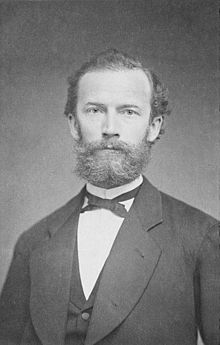Kohlrausch Law relates to the limiting molar conductivity of an electrolyte to its constituent ions.
It basically states that the limiting molar conductivity of an electrolyte is equal to the sum of individual limiting molar conductivities of the cations and anions which make up the electrolyte.
Limiting Molar Conductivity?
The molar conductivity of a solution at infinite dilution is known as limiting molar conductivity
This law is also popularly known as the Kohlrausch Law of Independent Migration.
Kohlrausch law and its applications are very important in the study of dilute solutions and also in the study of electrochemical cells. This law is mainly used to find the limiting conductivity of a weak electrolyte, among other important applications.
An example of this law is the limiting conductivity of sulphuric acid(H2SO4). The limiting molar conductivity of sulphuric acid is equal to the sum of the limiting conductivities of hydrogen cation and sulphate anion.
The mathematical representation of the above statement is,
\(\lambda^{\infty}_{H_2SO_4} = 2\lambda^{\infty}_{H^{+}} + \lambda^{\infty}_{SO_{4}^{2-}}\)Here, \(\lambda^{\infty}\) is the limiting molar conductivity.
Index
History
Friedrich Kohlrausch, a german physicist, gave this law in 1875-1879 and was thus named after him.
Kohlrausch played an important part in the development of physical chemistry and was an influential researcher of electrochemistry during his time.
The experiments which he used in order to develop the law of independent migration were used by famous and important chemists like Arrhenius, Ostwald and Van’t Hoff, who devised the Ionist theory and were called the founders of physical chemistry.

Kohlrausch Law Explained
The law of independent migration of ions states that the limiting molar conductivity of an electrolyte (i.e, the conductivity of an electrolyte at infinite dilution when all of it is dissociated into ions), is equal to the sum of the amount of its each constituent ion’s limiting molar conductivity.
The general case of this law is any random electrolyte AxBy.
The mathematical representation of the limiting molar conductivity of AxBy is,
\(\lambda^{\infty}_{A_xB_y} = 2\lambda^{\infty}_{A^{+y}} + \lambda^{\infty}_{B^{-x}}\)
Here, \(\lambda^{\infty}\) is the limiting molar conductivity.
When a pair of electrolytes have the same cation then the difference in their limiting molar conductivities does not depend on the cation and is only affected by a change in the anion.
The above statement is also true for electrolytes with the same anion.
Let us consider two pairs of electrolytes with common cations A and D in each pair, then the difference between their limiting molar conductivities is not affected by A or D. This can be mathematically represented as,
\(\lambda^{\infty}_{AB} – \lambda^{\infty}_{AC} = \lambda^{\infty}_{DB} – \lambda^{\infty}_{DC}\)
Here,
\(\lambda^{\infty}_{AB}\) is limiting molar conductivity of AB
\(\lambda^{\infty}_{AC}\) is limiting molar conductivity of AC
\(\lambda^{\infty}_{DB}\) is limiting molar conductivity of DB
\(\lambda^{\infty}_{DC}\) is limiting molar conductivity of DC
Applications of Kohlrausch Law
- It is used to calculate the dissociation constant of an electrolyte.
- It is used to calculate the limiting molar conductivity of a weak electrolyte.
- The degrees of dissociation of weak electrolytes are also found using this law.
- Solubility constants of various salts are also calculated using this law.
- It is also used in the calculation of the cell potential in various electrochemical cells.
Example Problems
Question 1. Calculate the limiting molar conductivity of sodium sulphate(Na2SO4). If the limiting molar conductivity of \(Na^{+}\) is \(50.1 S.cm^2/mol\) and \(\frac{1}{2}SO_{4}^{2-}\) is \(80.0 S.cm^2/mol\).
Solution. Given,
\(\lambda^{\infty}_{Na^{+}} = 50.1 S.cm^2/mol\)
\(\frac{1}{2}\lambda^{\infty}_{SO_{4}^{2-}} = 80.0 S.cm^2/mol\)
According to Kohlrausch law of independent migration of ions,
\(\lambda^{\infty}_{Na_2SO_4} = 2\lambda^{\infty}_{Na^{+}} + 2*(\frac{1}{2}\lambda^{\infty}_{SO{4}^{2-}})\)
\(\lambda^{\infty}_{Na_2SO_4} = 2(50.1) + 2*80\)
=> \(\lambda^{\infty}_{Na_2SO_4} = 260.2 S.cm^2/mol\)
So, the limiting molar conductivity of sodium sulphate is \(260.2 S.cm^2/mol\).
Question 2. Calculate the limiting molar conductivity of CH3COOH which is a weak electrolyte. The molar conductivities of CH3COONa, HCl and NaCl at infinite dilution are \(90.1 S.cm^2/mol\), \(426.16 S.cm^2/mol\) and \(126.45 S.cm^2/mol\) respectively.
Solution. Given,
\(\lambda^{\infty}_{CH_3COONa} = 90.1 S.cm^2/mol\)
\(\lambda^{\infty}_{HCL} = 426.16 S.cm^2/mol\)
\(\lambda^{\infty}_{NaCl} = 126.45 S.cm^2/mol\)
According to Kohlrausch law of independent migration of ions,
\(\lambda^{\infty}_{CH_3COOH} = \lambda^{\infty}_{CH_3COONa} + \lambda^{\infty}_{HCL} – \lambda^{\infty}_{NaCl}\)
\(\lambda^{\infty}_{CH_3COOH} = 91 + 426.16 – 126.45\)
=> \(\lambda^{\infty}_{CH_3COOH} = 390.71 S.cm^2/mol\)
So, the limiting molar conductivity of Acetic acid(CH3COOH) is, \(390.71 S.cm^2/mol\).
FAQs
Friedrich Kohlrausch discovered this law from observing experimental data of conductivities of various electrolytes.
This law is used to calculate the limiting molar conductivity, degree of dissociation and dissociation constant of weak electrolytes. It is also used in the measurement of the solubility of a salt.
It is the law that gives the relationship between the limiting molar conductivity of an electrolyte and its constituent ions. It states that the limiting molar conductivity of an electrolyte is equal to sum of the amounts of limiting molar conductivities of the ions which it splits into after dilution. The mathematical relation is,
\(\lambda^{\infty}_{A_xB_y} = 2\lambda^{\infty}_{A^{+y}} + \lambda^{\infty}_{B^{-x}}\)
This law was discovered by Kohlrausch in his experiments with dilute solutions. He backed up his law by the observation that, when a pair of different electrolytes have the same anode(or cathode) then the difference in their limiting molar conductivities is independent of the nature/type of the common anode(or cathode).
